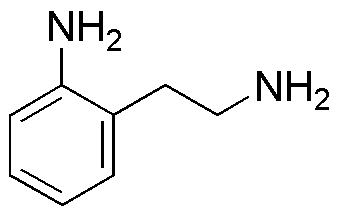2-(2-Aminoethyl)phenylamine is widely utilized in research focused on:
- Pharmaceutical Development: This compound serves as a key intermediate in the synthesis of various pharmaceuticals, particularly in the development of drugs targeting neurological disorders.
- Polymer Chemistry: It is used in the formulation of specialty polymers, enhancing properties such as thermal stability and mechanical strength, making it valuable in the production of high-performance materials.
- Analytical Chemistry: The compound acts as a reagent in analytical methods, aiding in the detection and quantification of certain biomolecules, which is crucial for research in biochemistry and molecular biology.
- Coating and Adhesive Formulations: It is incorporated into coatings and adhesives, providing improved adhesion and durability, which is essential in industries such as automotive and construction.
- Biotechnology: This chemical is explored for its potential in bioconjugation processes, facilitating the development of targeted drug delivery systems and diagnostic tools.
General Information
Properties
Safety and Regulations
Applications
2-(2-Aminoethyl)phenylamine is widely utilized in research focused on:
- Pharmaceutical Development: This compound serves as a key intermediate in the synthesis of various pharmaceuticals, particularly in the development of drugs targeting neurological disorders.
- Polymer Chemistry: It is used in the formulation of specialty polymers, enhancing properties such as thermal stability and mechanical strength, making it valuable in the production of high-performance materials.
- Analytical Chemistry: The compound acts as a reagent in analytical methods, aiding in the detection and quantification of certain biomolecules, which is crucial for research in biochemistry and molecular biology.
- Coating and Adhesive Formulations: It is incorporated into coatings and adhesives, providing improved adhesion and durability, which is essential in industries such as automotive and construction.
- Biotechnology: This chemical is explored for its potential in bioconjugation processes, facilitating the development of targeted drug delivery systems and diagnostic tools.
Documents
Safety Data Sheets (SDS)
The SDS provides comprehensive safety information on handling, storage, and disposal of the product.
Product Specification (PS)
The PS provides a comprehensive breakdown of the product’s properties, including chemical composition, physical state, purity, and storage requirements. It also details acceptable quality ranges and the product's intended applications.
Certificates of Analysis (COA)
Search for Certificates of Analysis (COA) by entering the products Lot Number. Lot and Batch Numbers can be found on a product’s label following the words ‘Lot’ or ‘Batch’.
Numéro de catalogue
Numéro de lot/série
Certificates Of Origin (COO)
This COO confirms the country where the product was manufactured, and also details the materials and components used in it and whether it is derived from natural, synthetic, or other specific sources. This certificate may be required for customs, trade, and regulatory compliance.
Numéro de catalogue
Numéro de lot/série
Safety Data Sheets (SDS)
The SDS provides comprehensive safety information on handling, storage, and disposal of the product.
DownloadProduct Specification (PS)
The PS provides a comprehensive breakdown of the product’s properties, including chemical composition, physical state, purity, and storage requirements. It also details acceptable quality ranges and the product's intended applications.
DownloadCertificates of Analysis (COA)
Search for Certificates of Analysis (COA) by entering the products Lot Number. Lot and Batch Numbers can be found on a product’s label following the words ‘Lot’ or ‘Batch’.
Numéro de catalogue
Numéro de lot/série
Certificates Of Origin (COO)
This COO confirms the country where the product was manufactured, and also details the materials and components used in it and whether it is derived from natural, synthetic, or other specific sources. This certificate may be required for customs, trade, and regulatory compliance.


